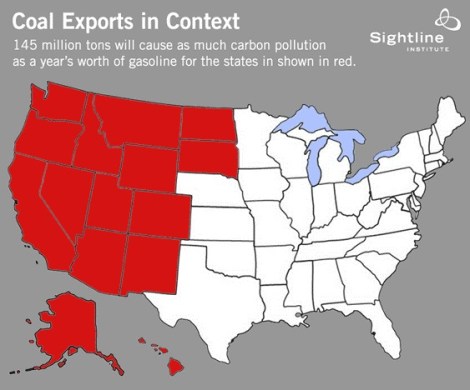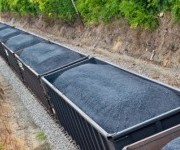A version of this article originally appeared on Sightline Daily.
There are at present six proposals to export coal from Northwest ports. If all of these proposals are built, and if all of them operate at full capacity, the Northwest would be shipping 145 million tons of per coal year.
When burned, that coal will produce roughly 262 million tons of carbon dioxide per year. It’s such a staggering figure that it’s a little hard to grasp. So here’s some context:

The coal export proposals are, in other words, a disaster for the climate. In aggregate, they are actually far worse than the Keystone XL pipeline.
If you want to dig into the numbers on a project-by-project basis, here they are:
- Cherry Point, Wash. SSA Marine is planning to build and operate the Gateway Pacific Terminal, a new shipping facility north of Bellingham, Wash., that would be capable of handling 48 million tons of coal per year. Peabody Energy, the world’s largest private sector coal company, has already agreed to supply 24 million tons of coal.
- Longview, Wash. Millennium Bulk Terminals, a subsidiary of the Australian coal mining company Ambre Energy, purchased a port site on the Columbia River. Arch Coal, a major American coal mining company, has a 38 percent stake in the site. Ambre hopes to export 44 million tons of coal, with 25 million tons in the first phase.
- Grays Harbor, Wash. According to newspaper accounts, RailAmerica is planning to develop a coal export terminal at the Port of Grays Harbor’s Marine Terminal 3 that could handle 5 million tons of coal each year.
- Port of St. Helens, Ore. Kinder Morgan is planning to build and operate a coal export terminal at the Port Westward Industrial Park near Clatskanie, Ore., that will be capable of handling 30 million tons of coal per year, with 15 million tons in an initial phase of development.
- Port of Morrow, Ore. Ambre Energy is planning to construct a facility on the Columbia River in eastern Oregon that will transfer coal from rail to barges that will be towed downriver to Port Westward, where the coal will be loaded on ongoing vessels. The company says that the system will be capable of handling 8 million tons per year.
- Coos Bay, Ore. The Port of Coos Bay is considering a mysterious proposal, known to the public only as “Project Mainstay,” that officials say could export 6 to 10 million tons of coal per year.
Notes: My calculations assume that Powder River Basin coal generates 8,500 British thermal units (BTUs) per pound, and that 1 million BTUs produce 212.7 pounds of CO2. Gasoline consumption refers to “motor gasoline” and comes the U.S. Federal Highway Administration’s statistics, which assume 19.6 pounds of carbon dioxide per gallon of gasoline.




